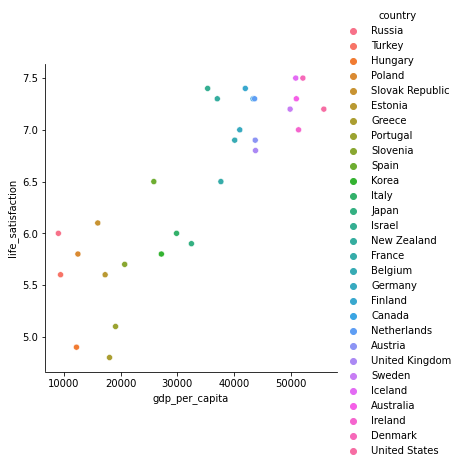Linear Regression in Python
Contents
Linear Regression in Python#
Does money make people happier? Version with data splitting.
Data#
Import#
import pandas as pd
# Load the data from GitHub
LINK = "https://raw.githubusercontent.com/kirenz/datasets/master/oecd_gdp.csv"
df = pd.read_csv(LINK)
df.head()
| Country | GDP per capita | Life satisfaction | |
|---|---|---|---|
| 0 | Russia | 9054.914 | 6.0 |
| 1 | Turkey | 9437.372 | 5.6 |
| 2 | Hungary | 12239.894 | 4.9 |
| 3 | Poland | 12495.334 | 5.8 |
| 4 | Slovak Republic | 15991.736 | 6.1 |
df.tail()
| Country | GDP per capita | Life satisfaction | |
|---|---|---|---|
| 24 | Iceland | 50854.583 | 7.5 |
| 25 | Australia | 50961.865 | 7.3 |
| 26 | Ireland | 51350.744 | 7.0 |
| 27 | Denmark | 52114.165 | 7.5 |
| 28 | United States | 55805.204 | 7.2 |
df.info()
<class 'pandas.core.frame.DataFrame'>
RangeIndex: 29 entries, 0 to 28
Data columns (total 3 columns):
# Column Non-Null Count Dtype
--- ------ -------------- -----
0 Country 29 non-null object
1 GDP per capita 29 non-null float64
2 Life satisfaction 29 non-null float64
dtypes: float64(2), object(1)
memory usage: 824.0+ bytes
Correct format#
# Change column names
df.columns = df.columns.str.lower().str.replace(' ', '_')
df.head()
| country | gdp_per_capita | life_satisfaction | |
|---|---|---|---|
| 0 | Russia | 9054.914 | 6.0 |
| 1 | Turkey | 9437.372 | 5.6 |
| 2 | Hungary | 12239.894 | 4.9 |
| 3 | Poland | 12495.334 | 5.8 |
| 4 | Slovak Republic | 15991.736 | 6.1 |
Exploration#
%matplotlib inline
import seaborn as sns
# Visualize the data
sns.relplot(x="gdp_per_capita", y='life_satisfaction', hue='country', data=df);

Data split#
# Select feature for simple regression
X = df[['gdp_per_capita']]
# Create response
y = df["life_satisfaction"]
from sklearn.model_selection import train_test_split
# Train Test Split
X_train, X_test, y_train, y_test = train_test_split(X, y, test_size=0.2, random_state=42)
Model#
Simple linear regression
Training#
from sklearn.linear_model import LinearRegression
# Select a linear regression model
reg = LinearRegression()
# Train the model
reg.fit(X_train, y_train)
LinearRegression()In a Jupyter environment, please rerun this cell to show the HTML representation or trust the notebook.
On GitHub, the HTML representation is unable to render, please try loading this page with nbviewer.org.
LinearRegression()
# Model coefficients
print('Coefficients: \n', "Intercept:", reg.intercept_, "\n Coefficient:", reg.coef_)
Coefficients:
Intercept: 4.867383809184242
Coefficient: [4.9184703e-05]
Prediction#
# Prediction
y_pred = reg.predict(X_test)
Evaluation#
from sklearn.metrics import r2_score
r2_score(y_test, y_pred)
0.7578144582350161
# pretty output
print("Coefficient of determination: %.2f" % r2_score(y_test, y_pred))
Coefficient of determination: 0.76
from sklearn.metrics import mean_squared_error
# Mean squared error
mean_squared_error(y_test, y_pred)
0.09021411430745645
# Root mean squared error
mean_squared_error(y_test, y_pred, squared=False)
0.30035664518611277
Use model#
# Create a new GDP value
X_new = pd.DataFrame({"gdp_per_capita": [50000]})
# Make a prediction for new GDP value
reg.predict(X_new)
array([7.32661896])
Save and load model#
from pathlib import Path
# show current working directory
Path.cwd()
PosixPath('/home/runner/work/analytics/analytics/docs')
It is possible to save a model in scikit-learn by using joblib’s dump and load:
from joblib import dump, load
# store model in current working directory with Path()
dump(reg, Path('my_linear_model.joblib'))
['my_linear_model.joblib']
# load model and save it as reg2
reg2 = load(Path('my_linear_model.joblib'))
# make a prediction
reg2.predict(X_new)
array([7.32661896])

